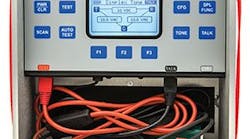Latest from Home
I’ve been on a kick writing about replacement multifunctional test sets for the Dynatel 965. In the process, I spoke with a provider of a set manufactured for construction conformance testing. Multifunctional test sets like the Dynatel 965, EXFO, JDSU, Megger, Copper Pro, and others, are used for conformance testing, but separate talk circuits and external tone sources have to be set up separately. One good answer to the problem is the AALogic D-105.
The AALogic D-105 Construction Test Set was designed primarily for conformance testing by construction splicing technicians. It adds testing features necessary in today’s market to assure a quality copper infrastructure. It addresses 3 primary functions: test/tone/talk, used for cable transfers; restoration; and testing helpful in qualifying pairs for DSL service.
A series of manual tests can be done. These tests include the 3-point terminal test that looks for DC voltages, resistive (OHMS) faults, and pair capacitance balance. If the pair is found to be clear of DC faults additional tests can be performed. These tests include: leakage, load coil sweep, noise, DSL balance, and a TDR scan.
The set can measure open cable pairs for distance, capacitive balance, and has a Time Domain Reflectometer (TDR), which uses both step and pulse technology. The downside is the test set does not have a resistance bridge that is necessary for cable maintenance.
Using the single button "AutoTest," the test set steps through a variety of tests to determine if any pair fault exists. A pair fault found that might be an obstacle for DSL provisioning is identified. If the pair passes the series of tests a "Pass" message is displayed, and if not, the fault condition found is shown.
Automatic testing "AutoTest" is pass/fail based on set thresholds. This test completes DC fault Identification (crossed battery, shorted and grounded cable pairs); provides a load coil count; and gives the approximate distance to the first load coil. The test set measures metallic/longitudinal noise. The "Z Stress" scans frequencies in the DSL range for high frequency imbalance conditions.
Manual selection of various tests is intuitive. Anytime within a manual test the user can jump to another selection. Manual tests include volts/resistance/capacitance; load coil detect/count; noise measurements (metallic and longitudinal); leakage; TDR (step and pulse); frequency spectrum scan; and circuit type identification (T1, HDSL, ADSL, ADSL2, VDSL). An extended "Z Stress" test measures tip/ring impedance balance at frequencies in the ADSL spectrum that can identify small series resistance problems.
The test set has Special Circuit Identification for T1, DSL, and HDSL. It has an extended stress feature to test for longitudinal balance. When testing with the conventional method in the audible frequency range, the set can define potential problems often overlooked.
In addition to testing capabilities, the set has unique tone generators helpful in locating pairs under adverse conditions. The user can select between simplex, triplex, and metallic tone (TR/TG/RG) based on the specific need. Voltages between TR, TG, and RG are monitored and displayed while sending tone. This provides visual indication of cable status, and gives indication when a short or ground condition is placed on the pair. When a short is detected a local "BUZZ" tone is sounded, and the tone cadence (pattern) changes to alert the remote technician using a tone probe of the pair status change.
The tone generator sends Data Safe Simplex (quiet tone), metallic (tip to ring), ring, and tip tones. The triplex tone reduces tone crossing over to other pairs. I like that.
For identification purposes the test set has short detection — both audible and visual. The test set monitors tone levels and line voltage and has a remote short detection with a tone change when the pair is shorted.
A common problem associated with sending simplex tone is bleed over, the inability to distinguish the pair on which the tone is being sent. The root cause of this phenomenon is poor bonding, no sheath continuity, or wet cable.
In many cases these problems can be minimized by reconnecting sheath, bonding old pairs to the sheath as pairs are transferred out of the old, and keeping all leads as short as possible. The benefit of sheath continuity, and good earth ground, is of utmost importance. A screwdriver in dry soil, or for that matter even in wet soil, isn’t always the answer. This especially holds true for test set ground leads.
In situations where tones are weak, or bleed over can’t be reduced sufficiently, the triplex tone mode can be used. This mode effectively doubles the amplitude of tone while minimizing tone crossover. Unlike minimal intrusive simplex, triplex is not silent to the customer and should only be used when no other method has been proven to be successful.
The test set has a constant current talk battery with Connect Notification. Talk battery voltage is varied by the test set to maintain a minimum talk current on short or long pairs.
When there is a need to establish communications between 2 points, and the use of a cell phone is either not practical or simply will not work, the test set can furnish Isolated Talk Battery. Unlike many other battery sources, the test set talk battery automatically adjusts to maintain adequate current to power a variety of headsets or electronic butt sets. Since the output voltage can extend to voltages beyond 30 volts, loop lengths of 30-40Kft do not present a problem.
This test set seems to be a quality test set for construction splicers doing conformance testing, and the price is right. The resistance bridge is a necessity for cable maintenance and is not included — so I don’t think that it is the best fit for the all-around cowboy.
Signing off
As I said in the beginning of this column, I haven’t written enough about construction splicing. I’d like to know if you want to read more about this topic, and if you have specific questions or comments related to construction that we can explore. Let me hear from you! [email protected] or 831.818.3930. And please check out our technical group discussions on LinkedIn: Copper Infrastructure Outside Plant Technical Challenges. If you would like to see my past columns in OSP magazine, go to www.ospmag.com.





